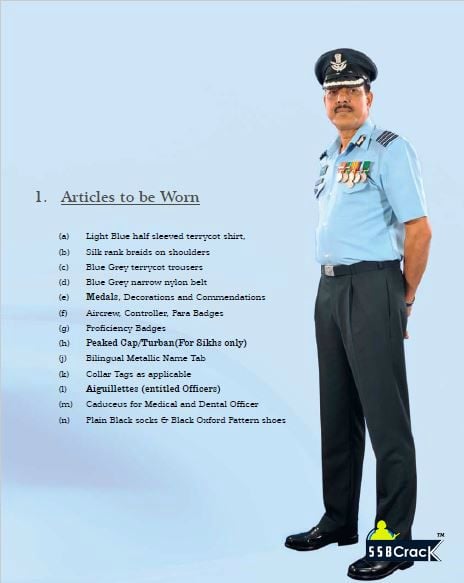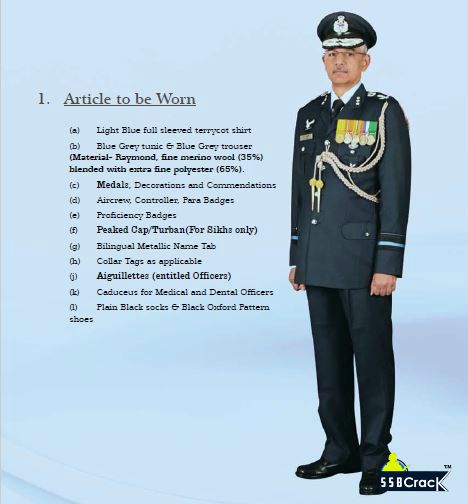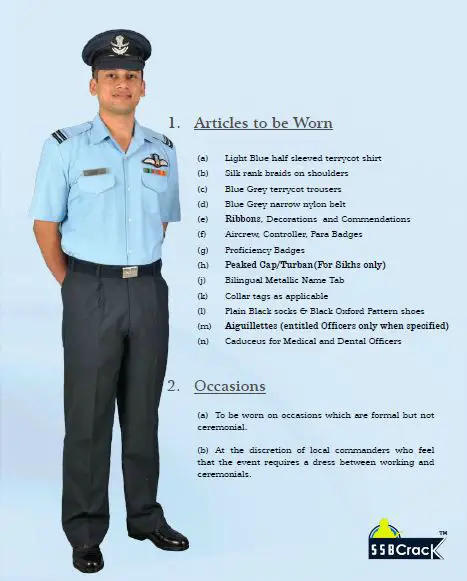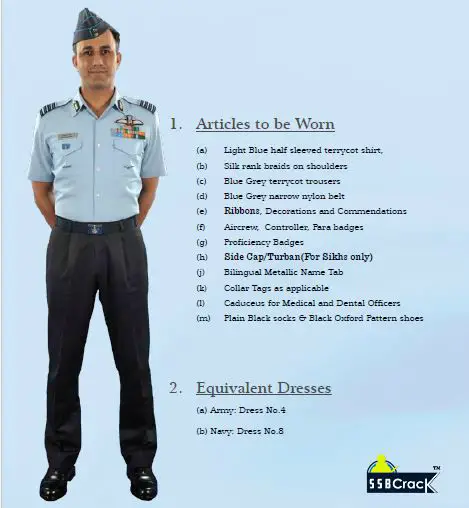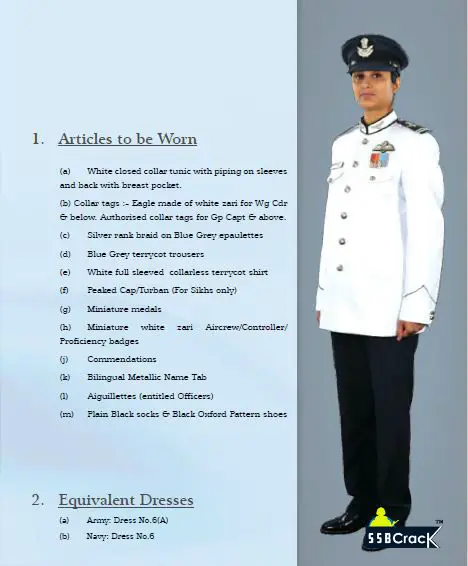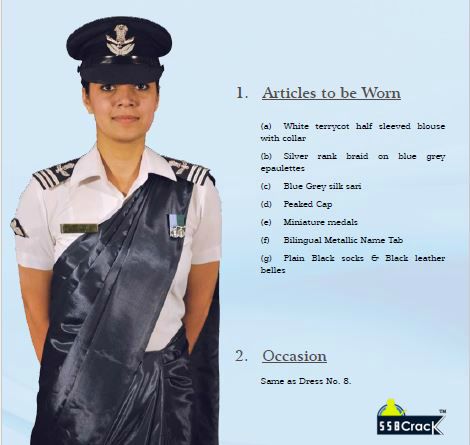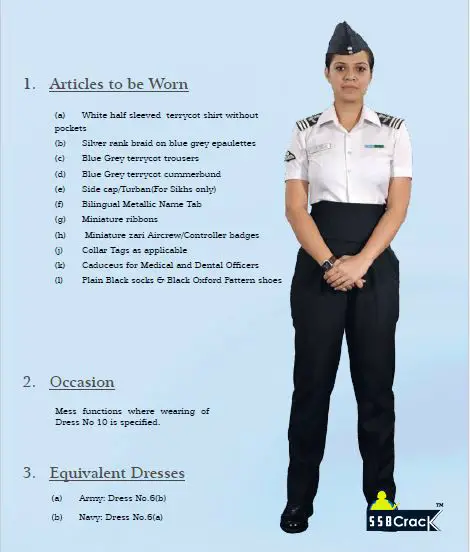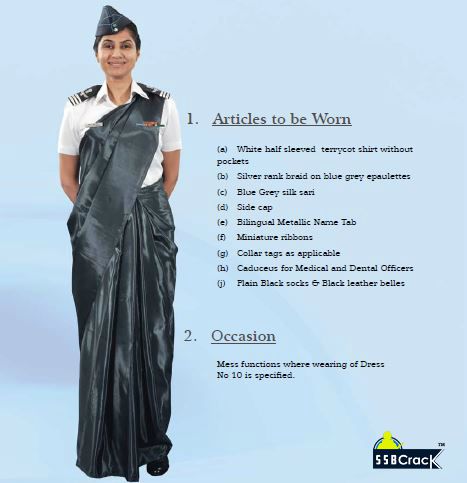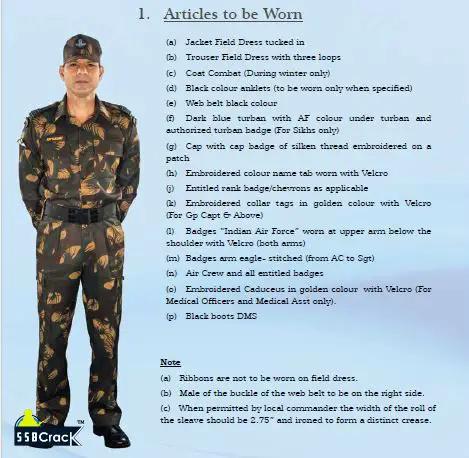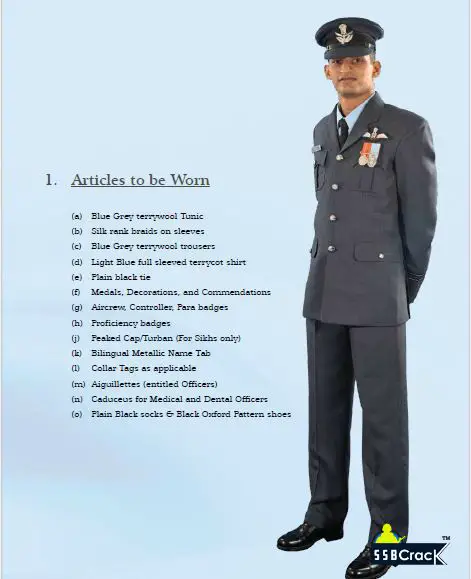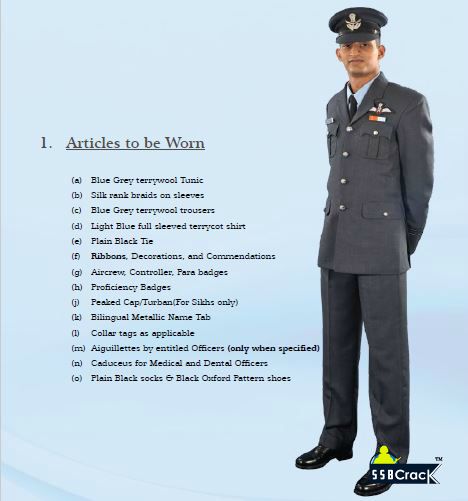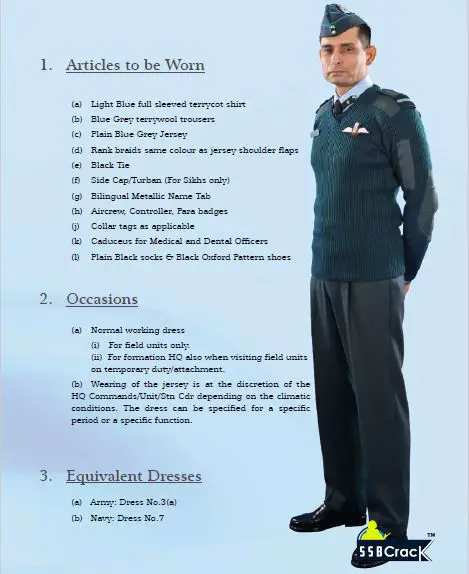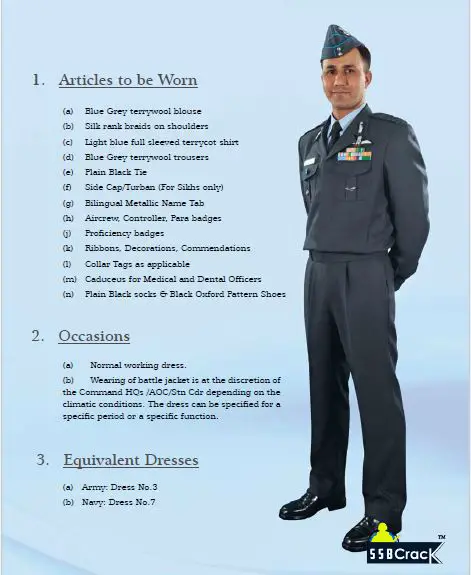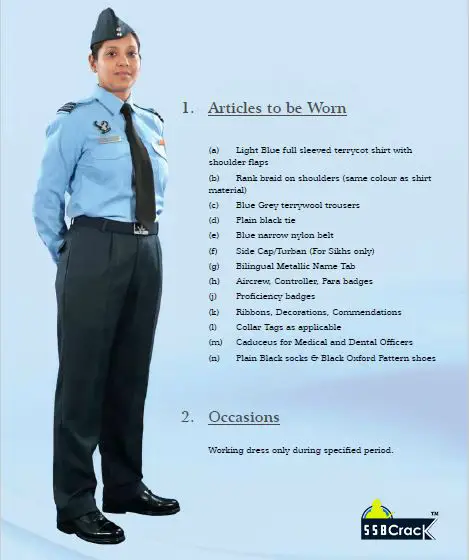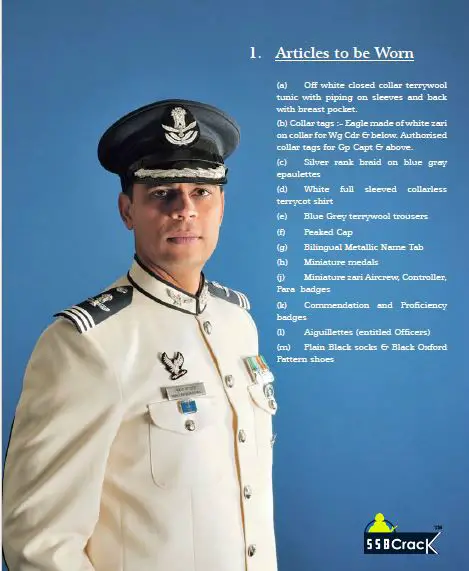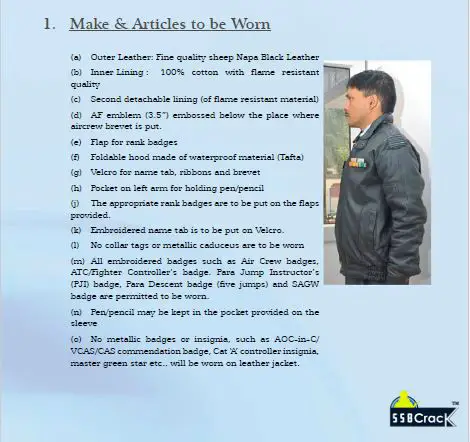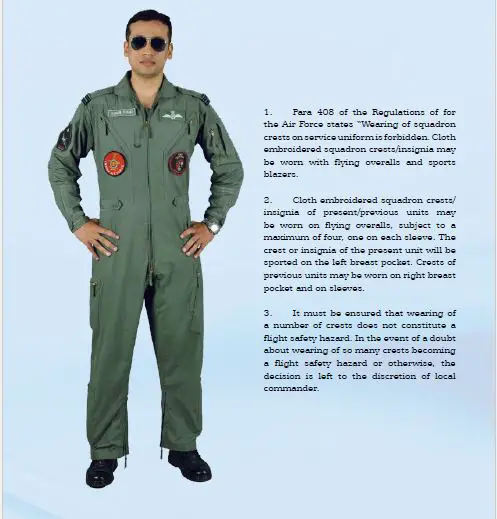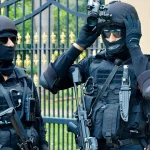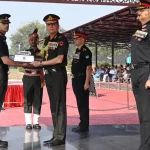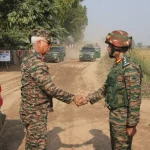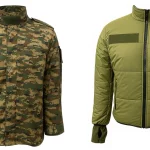When you think of the Indian Air Force (IAF), the first image that often comes to mind is that of a brave pilot soaring through the skies in a fighter jet. But beyond the machines, what truly distinguishes an air warrior is the uniform they wear with pride. Every IAF uniform is more than just fabric stitched together—it is a symbol of honor, responsibility, and sacrifice.
From ceremonial tunics to rugged field dress, from elegant mess attire to the coveted flying overalls, each of the 17 official uniforms of the IAF reflects the traditions, duties, and achievements of an air warrior. These uniforms are not freely worn; they must be earned through dedication, discipline, and service to the nation.
For defence aspirants, understanding these uniforms is more than just learning about dress codes—it is about appreciating the culture, professionalism, and pride of the Indian Air Force.
According to the occasion and purpose, a service personnel has to dress up in different uniforms. Here is a list of some such uniforms that a service personnel may have to wear in IAF, and along with it is the occasion on which it is worn.
Officers’ Uniform : Summer
1. Dress No. 2 – Summer Ceremonial Uniform
The Summer Ceremonial Dress of the Indian Air Force is one of the most distinguished uniforms, symbolizing pride, professionalism, and honor. This dress is primarily worn during official parades, ceremonial occasions, and important functions where officers represent the IAF in its most dignified form.
Key Features of the Uniform
- Shirt: A light blue half-sleeved terrycot shirt, perfectly ironed to maintain a crisp appearance.
- Trousers: Blue-grey terrycot trousers that complement the shirt.
- Rank Badges: Silk rank braids on the shoulders that reflect the officer’s service hierarchy.
- Belt: A blue-grey narrow nylon belt worn neatly around the waist.
- Headgear: A peaked cap, which is a symbol of authority (turban for Sikh officers).
- Footwear: Polished black Oxford pattern shoes with plain black socks.
Decorations and Insignia
The ceremonial uniform proudly displays:
- Medals, Decorations, and Commendations – showcasing an officer’s gallantry, service, and achievements.
- Aircrew, Controller, and Para Badges – earned through specialized training and operations.
- Proficiency Badges and Collar Tabs – representing technical and professional expertise.
- Bilingual Metallic Name Tab – signifying identity and belonging to the IAF family.
- Caduceus Badge – specifically worn by medical and dental officers.
Significance
This ceremonial dress is not just about presentation; it is a reminder of the service, discipline, and sacrifices of an air warrior. Worn during high-profile events such as Air Force Day, Passing Out Parades, and State ceremonies, it projects dignity and respect for the force.
2. Dress No. 2A – Summer Ceremonial (For Air Officers, AAs, DAs, SOs)
The Dress No. 2A Summer Ceremonial uniform is a highly prestigious attire, specifically designated for Air Officers, Air Attachés (AAs), Defence Attachés (DAs), and Staff Officers (SOs). This uniform reflects authority and senior leadership within the Indian Air Force, and it is primarily worn during state functions, high-level ceremonial occasions, and international military representations.
Key Features of the Uniform
- Shirt: Light blue, full-sleeved terrycot shirt, tucked in with precision.
- Tunic & Trousers: Blue-grey tunic paired with matching blue-grey trousers. The fabric is carefully chosen—Raymond fine merino wool (35%) blended with extra fine polyester (65%)—ensuring durability, comfort, and a sharp look in hot weather conditions.
- Headgear: Peaked cap (or turban for Sikh officers), symbolizing command and seniority.
- Shoes: Black Oxford pattern shoes with plain black socks.
Decorations and Distinctive Badges
- Medals, Decorations, and Commendations – displayed prominently, showcasing an officer’s achievements, gallantry awards, and distinguished service.
- Specialist Badges – Aircrew, Controller, and Para badges as per qualification.
- Proficiency Badges – worn with pride to signify technical expertise.
- Bilingual Metallic Name Tab – reinforcing identity and accessibility.
- Collar Tabs – denoting seniority and professional category.
- Aiguilettes – golden cords worn across the shoulder, signifying senior appointments (entitled officers only).
- Caduceus Badge – for medical and dental officers.
Significance
This ceremonial attire is one of the most dignified uniforms in the IAF. The tunic and aiguilettes make it distinct from the standard ceremonial uniform. It reflects not just personal achievements but also the prestige of the appointment held by the officer. When worn at diplomatic events or during state-level ceremonies, it symbolizes the global presence and high standards of the Indian Air Force.
3. Dress No. 4 – Summer Semi-Ceremonial
The Summer Semi-Ceremonial Dress of the Indian Air Force strikes a balance between formality and functionality. Unlike the full ceremonial dress, it is designed for occasions that demand dignity and formality but not the complete ceremonial setup. This uniform is most often seen during official gatherings, parades of a lower scale, or events where officers need to represent the force without the elaborate ceremonial accessories.
Key Features of the Uniform
- Shirt: Light blue half-sleeved terrycot shirt, with silk rank braids on the shoulders.
- Trousers: Blue-grey terrycot trousers, complementing the shirt.
- Belt: Blue-grey narrow nylon belt, practical and neat in appearance.
- Headgear: Peaked cap or turban (for Sikh officers).
- Footwear: Black Oxford pattern shoes with plain black socks.
- Accessories:
- Ribbons, Decorations, and Commendations in ribbon form instead of full medals.
- Aircrew, Controller, and Para Badges proudly displayed.
- Proficiency Badges and Collar Tabs as applicable.
- Bilingual Metallic Name Tab for identity.
- Aiguilettes (worn only if specified for entitled officers).
- Caduceus Badge for Medical and Dental officers.
Occasions for Wearing
- Formal but Non-Ceremonial Events: This dress is used when the occasion is formal, yet does not require full ceremonial attire.
- At Local Commander’s Discretion: The decision to wear this uniform is often left to commanding officers, depending on the nature of the event and its importance.
Significance
The Summer Semi-Ceremonial uniform reflects the adaptability of the IAF dress regulations. It projects a professional appearance while allowing officers to maintain comfort in India’s summer conditions. The use of ribbons instead of full medals is a mark of respect and recognition while keeping the attire lighter than the ceremonial version.
4. Dress No. 6 – Summer Working
The Summer Working Dress is the Indian Air Force’s most commonly worn uniform during daily official duties in the warmer months. It reflects simplicity, discipline, and efficiency, while still carrying the dignity of the IAF. Unlike ceremonial and semi-ceremonial dresses, this attire is functional and tailored for everyday professional engagements.
Key Features of the Uniform
- Shirt: Light blue half-sleeved terrycot shirt with silk rank braids on the shoulders.
- Trousers: Blue-grey terrycot trousers for a neat, professional appearance.
- Belt: Blue-grey narrow nylon belt to secure the uniform.
- Headgear: Standard IAF cap or turban for Sikh officers.
- Footwear: Polished black Oxford pattern shoes with plain black socks.
- Accessories:
- Ribbons, Decorations, and Commendations (instead of full medals).
- Aircrew, Controller, and Para Badges as applicable.
- Proficiency Badges and Collar Tabs based on role and entitlement.
- Bilingual Metallic Name Tab for identification.
- Caduceus Badge for Medical and Dental Officers.
Equivalent Dresses in Other Services
- Army: Dress No. 6
- Navy: Dress No. 8
This highlights the inter-service alignment of working uniforms, ensuring a consistent sense of military discipline across all branches.
Significance
The Summer Working Dress is a symbol of routine professionalism in the IAF. While less formal than ceremonial attire, it is equally important because it is the uniform most often seen by the public, dignitaries, and fellow servicemen in day-to-day operations. It represents the air warrior’s constant readiness and discipline while allowing comfort in hot climates.
5. Dress No. 8 – Summer Ceremonial Mess Dress
The Summer Ceremonial Mess Dress is one of the most elegant uniforms of the Indian Air Force, worn during formal evening functions, mess events, and state banquets. It is equivalent to the Army’s Dress No. 6A and the Navy’s Dress No. 6, representing the highest standard of military dining etiquette and ceremonial tradition. This uniform combines dignity with a distinct formal aesthetic, making it a mark of prestige among officers.
Key Features of the Uniform
- Tunic: White closed-collar tunic with piping on the sleeves and back, featuring the IAF breast pocket.
- Collar Tags:
- Eagle made of white zari for Wing Commanders and below.
- Authorised collar tags for Group Captain and above.
- Epaulettes: Silver rank braid on blue-grey shoulder epaulettes.
- Shirt: White full-sleeved collared terrycot shirt worn underneath.
- Trousers: Blue-grey terrycot trousers, tailored for a sharp ceremonial appearance.
- Headgear: Peaked cap or turban (for Sikh officers).
- Footwear: Black Oxford pattern shoes with plain black socks.
- Accessories:
- Miniature medals and commendations.
- Miniature white zari Aircrew/Controller/Proficiency badges.
- Bilingual metallic name tab.
- Aiguilettes (for entitled officers).
Occasions for Wearing
The Mess Dress is the official uniform for:
- Formal military dinners and banquets.
- Mess functions, regimental gatherings, and state receptions.
- Events that require the utmost ceremonial appearance but in an evening/social environment.
Significance
The Mess Dress is a symbol of tradition and camaraderie within the armed forces. It fosters a sense of brotherhood among officers during mess evenings, where formality meets fellowship. Unlike working or semi-ceremonial uniforms, this attire is designed to enhance the prestige of formal gatherings, while showcasing an officer’s medals, rank, and service achievements in a dignified manner.
6. Dress No. 8A – Summer Mess Dress for Lady Officers (Pre & Post Natal)
The Summer Mess Dress for Lady Officers is a graceful and dignified attire that combines tradition with the unique identity of the Indian Air Force. Specifically designed for pre and post-natal lady officers, this dress ensures comfort while retaining the ceremonial essence of the IAF mess dress code. It mirrors the elegance of the male officer’s Mess Dress but is adapted into a sari form, blending Indian tradition with military discipline.
Key Features of the Uniform
- Blouse: White terrycot half-sleeved blouse with collar, designed for both comfort and a formal look.
- Sari: Blue-grey silk sari, the hallmark element of this dress, elegantly draped with precision.
- Epaulettes: Silver rank braid on blue-grey epaulettes, symbolizing the officer’s rank.
- Headgear: Peaked cap, emphasizing military bearing.
- Footwear: Black leather bellies paired with plain black socks for formal consistency.
- Accessories:
- Miniature medals displayed appropriately.
- Bilingual Metallic Name Tab for identification and formality.
Occasions for Wearing
- The Mess Dress for lady officers is worn during formal mess functions, ceremonial dinners, and banquets, similar to Dress No. 8.
- Ensures representation of the IAF’s values while giving female officers an attire that resonates with Indian culture.
Significance
This uniform represents a fusion of tradition and service identity. The sari, a symbol of grace in Indian culture, when combined with the Air Force rank insignia and medals, reflects the pride and honor of being an air warrior. It also underlines the inclusivity of the Indian Air Force, ensuring that female officers, including those in pre and post-natal phases, have a dignified and comfortable ceremonial dress.
7. Dress No. 10 – Summer Mess Dress
The Summer Mess Dress is a formal attire worn by Indian Air Force officers during mess functions and special social gatherings where ceremonial dress (Dress No. 8) is not prescribed. It reflects simplicity, neatness, and elegance while retaining the Air Force’s formal identity.
Key Features of the Uniform
- Shirt: White half-sleeved terrycot shirt without pockets, keeping the attire crisp and lightweight for summer evenings.
- Epaulettes: Silver rank braid on blue-grey epaulettes, denoting the officer’s position.
- Trousers: Blue-grey terrycot trousers, paired with a blue-grey cummerbund (waist sash) for a distinguished appearance.
- Headgear: Side cap (or turban for Sikh officers).
- Footwear: Polished black Oxford pattern shoes with plain black socks.
- Accessories:
- Miniature ribbons and medals displayed appropriately.
- Miniature zari Aircrew/Controller badges.
- Collar Tabs as applicable.
- Bilingual Metallic Name Tab.
- Caduceus Badge for Medical and Dental Officers.
Occasions for Wearing
- Primarily worn during mess functions where full ceremonial mess dress (Dress No. 8) is not mandated.
- Offers a balance between tradition and comfort, making it suitable for semi-formal evening social settings.
Equivalent Dresses in Other Services
- Army: Dress No. 6B
- Navy: Dress No. 6B
This inter-service equivalence highlights the uniformity of traditions across the Indian Armed Forces.
Significance
The Summer Mess Dress is a symbol of camaraderie and fellowship among officers. While it does not carry the grandeur of the ceremonial mess dress, it embodies discipline, dignity, and the unique ethos of the Air Force. This dress ensures that even in informal or semi-formal gatherings, the IAF identity is carried with pride.
8. Dress No. 10A – Summer Mess Dress for Lady Officers (Pre & Post Natal)
The Summer Mess Dress for Lady Officers (Pre & Post Natal) is a dignified and comfortable variation of the mess attire, designed specifically for female officers. It ensures that women officers can participate in formal mess functions while maintaining the grace of traditional Indian attire combined with the discipline of military uniformity.
Key Features of the Uniform
- Blouse: White half-sleeved terrycot shirt without pockets, offering comfort in the summer heat.
- Sari: Blue-grey silk sari draped formally, symbolizing elegance and identity.
- Epaulettes: Silver rank braid on blue-grey epaulettes to denote rank.
- Headgear: Side cap (or turban for Sikh officers).
- Footwear: Black leather bellies with plain black socks.
- Accessories:
- Miniature ribbons and medals.
- Miniature zari Aircrew/Controller badges.
- Collar Tabs as applicable.
- Bilingual Metallic Name Tab.
- Caduceus Badge for Medical and Dental Officers.
Occasion for Wearing
- Worn during mess functions where Dress No. 10 is prescribed.
- Serves as the female equivalent of the male officer’s Summer Mess Dress.
Significance
This dress reflects the IAF’s commitment to inclusivity, ensuring that women officers have a formal yet culturally resonant option for mess occasions. The sari, blended with military insignia and medals, symbolizes both grace and duty. It allows lady officers, including those in pre and post-natal phases, to maintain the dignity of Air Force traditions while prioritizing comfort.
9. Dress No. 12 – Summer/Winter Field Dress (Common to Officers & Airmen)
The Field Dress (Dress No. 12) is the combat uniform of the Indian Air Force, worn by both officers and airmen during operational duties, exercises, and field postings. It is designed for practicality, camouflage, and mobility, ensuring that air warriors are mission-ready in diverse terrains and weather conditions.
Key Features of the Uniform
- Jacket & Trousers:
- Jacket-style field dress tucked in, paired with trousers having three loops for sturdiness.
- Durable design suited for both summer and winter conditions.
- Coat Combat: Worn additionally during winter for warmth.
- Footwear: Black combat ankle boots (DMS) for rugged mobility.
- Headgear:
- Standard field cap (with IAF insignia).
- Dark blue turban with Air Force colour band (for Sikh officers).
- Badges & Insignia:
- Embroidered collar tags in golden colour with Velcro (Gp Capt & above).
- Eagle collar tags for Wg Cdr & below.
- “Indian Air Force” Badge embroidered in golden colour, worn on the upper arm below the shoulder.
- Rank badges stitched in golden thread with Velcro.
- Aircrew and specialist badges as entitled.
- Embroidered caduceus for Medical Officers and Medical Assistants.
- Name tab & IAF crest badges embroidered in golden thread with Velcro fastening.
- Belt: Black nylon web belt (with specific buckle placement for neatness).
Notes for Wearing
- Ribbons/medals are not to be worn with this dress.
- Web belt buckle is worn on the right side.
- Local commanders may permit creased sleeves (2.75″ width) to maintain neatness.
Significance
The Field Dress is the battle uniform of the IAF, symbolizing readiness, resilience, and operational efficiency. Unlike ceremonial or mess uniforms, this attire is designed purely for functionality in combat and field environments. It projects the air warrior’s adaptability—whether in desert, jungle, high-altitude, or base operations.
Officers’ Uniform : Winter
10. Dress No. 1 – Winter Ceremonial
The Winter Ceremonial Dress is among the most prestigious uniforms of the Indian Air Force, worn during state functions, parades, and occasions of the highest military significance in the winter season. Distinguished by its blue-grey tunic, this dress embodies the pride, dignity, and heritage of the IAF.
Key Features of the Uniform
- Tunic & Trousers:
- Blue-grey terrycool tunic with silk rank braids on sleeves.
- Blue-grey terrycool trousers neatly pressed for a sharp look.
- Shirt: Light blue full-sleeved terrycot shirt, worn under the tunic.
- Headgear: Peaked cap (or turban for Sikh officers).
- Footwear: Black Oxford pattern shoes with plain black socks.
- Accessories & Decorations:
- Full medals, decorations, and commendations proudly displayed.
- Aircrew, Controller, Para, and Proficiency badges.
- Bilingual Metallic Name Tab.
- Collar Tabs as applicable.
- Aiguilettes for entitled officers.
- Caduceus Badge for Medical and Dental Officers.
- Belt: Plain black tie, completing the formal ceremonial look.
Occasions for Wearing
- High-level ceremonial parades, including Air Force Day and Republic Day celebrations in winter.
- State functions where the Indian Air Force is formally represented.
- Events of military importance requiring the display of medals and gallantry awards.
Significance
This uniform is a symbol of legacy and valor. The full tunic with medals projects the decorated service of the officer and the enduring traditions of the IAF. The Winter Ceremonial dress stands as a mark of respect to the service, sacrifices, and achievements of air warriors who guard the nation’s skies.
11. Dress No. 3 – Winter Semi-Ceremonial
The Winter Semi-Ceremonial Dress is a formal yet less elaborate version of the Winter Ceremonial attire. It is worn on occasions that demand respect and dignity, but do not require the full ceremonial display of medals. This makes it versatile for a wide range of official and military gatherings during the winter season.
Key Features of the Uniform
- Tunic & Trousers:
- Blue-grey terrycool tunic with silk rank braids on sleeves.
- Matching blue-grey terrycool trousers for a professional appearance.
- Shirt & Tie: Light blue full-sleeved terrycot shirt paired with a plain black tie.
- Headgear: Peaked cap (or turban for Sikh officers).
- Footwear: Black Oxford pattern shoes with plain black socks.
- Accessories & Decorations:
- Ribbons for decorations, commendations, and service medals (instead of full medals).
- Aircrew, Controller, and Para badges.
- Proficiency Badges based on qualifications.
- Bilingual Metallic Name Tab.
- Collar Tabs as applicable.
- Aiguilettes (only when specified for entitled officers).
- Caduceus Badge for Medical and Dental Officers.
Occasions for Wearing
- Events that are formal but not fully ceremonial, such as official functions, gatherings, and dignitary receptions.
- Suitable for parades and duties in winter where ribbons are displayed instead of medals.
Significance
The Winter Semi-Ceremonial Dress represents a balance between honor and practicality. While it does not carry the grandeur of the full ceremonial uniform, it still displays achievements and qualifications through ribbons and badges. It embodies the disciplined yet flexible nature of the IAF, ensuring officers maintain decorum while adapting to the requirements of different occasions.
12. Dress No. 5 – Winter Working
The Winter Working Dress is the standard daily working attire of the Indian Air Force during the colder months. Designed for practicality while retaining formal military decorum, it ensures comfort in winter climates while keeping officers smartly turned out.
Key Features of the Uniform
- Shirt & Jersey:
- Light blue full-sleeved terrycot shirt.
- Plain blue-grey jersey (sweater), adding warmth and formality.
- Trousers: Blue-grey terrycool trousers, neat and well-pressed.
- Rank Display: Rank braids in the same colour as jersey shoulder flaps.
- Tie: Plain black tie to complete the formal appearance.
- Headgear: Side cap (or turban for Sikh officers).
- Footwear: Black Oxford pattern shoes with plain black socks.
- Accessories & Badges:
- Bilingual Metallic Name Tab.
- Aircrew, Controller, and Para badges.
- Proficiency badges and Collar tabs.
- Caduceus Badge for Medical and Dental Officers.
Occasions for Wearing
- Routine Working Days: The standard winter dress for normal office and working duties.
- Field Units: Authorized as working attire for officers in field environments.
- Formations HQ & Visits: Worn by officers when visiting field units on temporary duty/attachment.
- Commanding Authority Discretion: HQ or Unit Commanders may prescribe its use based on climate or special events.
Equivalent Dresses in Other Services
- Army: Dress No. 3(a)
- Navy: Dress No. 7
This ensures harmony across the services, with each branch adapting working attire to their environment while maintaining uniformity in spirit.
Significance
The Winter Working Dress is practical yet formal, ensuring officers remain presentable, warm, and professional in winter. It highlights the adaptability of IAF uniforms to seasonal and operational needs while retaining the identity of the service through its distinct blue-grey theme.
13. Dress No. 7 – Winter Working
The Winter Working Dress (Dress No. 7) is a practical and formal uniform used by IAF officers during winter months. It is similar to Dress No. 5, but with slight variations in attire depending on the commanding officer’s discretion and the climatic conditions. This uniform is primarily designed for daily working duties while maintaining a smart military bearing.
Key Features of the Uniform
- Blouse & Shirt:
- Blue-grey terrycool blouse with silk rank braids on shoulders.
- Light blue full-sleeved terrycot shirt worn inside.
- Trousers: Blue-grey terrycool trousers, pressed neatly for formality.
- Tie: Plain black tie to maintain military discipline in formal dress.
- Headgear: Side cap (or turban for Sikh officers).
- Footwear: Black Oxford pattern shoes with plain black socks.
- Accessories & Badges:
- Bilingual Metallic Name Tab.
- Aircrew, Controller, and Para badges.
- Proficiency badges and Collar Tabs as applicable.
- Ribbons for decorations and commendations (instead of full medals).
- Caduceus Badge for Medical and Dental Officers.
Occasions for Wearing
- Normal Working Dress: The standard uniform for daily working duties in winter.
- Climatic Adaptation: Use of blouse and layers is decided by Command HQs / AOC / Station Commander, based on weather and operational requirements.
- Can also be prescribed for specific functions or parades where semi-formal working attire is suitable.
Equivalent Dresses in Other Services
- Army: Dress No. 3
- Navy: Dress No. 7
This reflects the inter-service uniformity while allowing branch-specific distinctions in colour and design.
Significance
Dress No. 7 represents the professional everyday image of the IAF during winter. Practical and comfortable, it ensures officers can perform their duties effectively while maintaining a formal and disciplined appearance in line with military traditions.
14. Dress No. 7A – Winter Working
The Winter Working Dress (Dress No. 7A) is a practical variation of the working uniform, prescribed for use only during a specified period in the winter season. It is a simplified working attire that prioritizes comfort and utility while retaining the professional identity of the Indian Air Force.
Key Features of the Uniform
- Shirt: Light blue full-sleeved terrycot shirt with shoulder flaps.
- Rank Display: Rank braid on the shoulders in the same colour as the shirt material, ensuring neatness.
- Trousers: Blue-grey terrycool trousers for a sharp and disciplined appearance.
- Tie: Plain black tie.
- Belt: Blue narrow nylon belt for secure fitting.
- Headgear: Side cap (or turban for Sikh officers).
- Footwear: Black Oxford pattern shoes with plain black socks.
- Accessories & Badges:
- Bilingual Metallic Name Tab.
- Aircrew, Controller, and Para badges.
- Proficiency badges and Collar Tabs as applicable.
- Ribbons, Decorations, and Commendations.
- Caduceus Badge for Medical and Dental Officers.
Occasions for Wearing
- Worn specifically as a working dress during defined winter periods.
- Issued at the discretion of higher commands or station authorities, depending on climatic and operational requirements.
Significance
This uniform underscores the seasonal adaptability of the IAF dress code. While similar to other working dresses, its limited usage period ensures officers remain comfortable and appropriately dressed for winter operations without the need for a full blouse or tunic. It represents the IAF’s balance between discipline, functionality, and practicality.
15. Dress No. 9 – Winter Ceremonial Mess Dress
The Winter Ceremonial Mess Dress is the Indian Air Force’s most distinguished evening attire for officers during the winter season. Worn at formal mess events, banquets, and state receptions, this uniform symbolizes prestige, tradition, and honor. It is the winter counterpart to the Summer Mess Dress, designed for elegance in colder months.
Key Features of the Uniform
- Tunic & Shirt:
- Off-white closed-collar terrycool tunic with piping on sleeves and back, featuring a breast pocket.
- White full-sleeved collared terrycot shirt worn inside.
- Trousers: Blue-grey terrycool trousers for contrast and sharpness.
- Epaulettes: Silver rank braid on blue-grey epaulettes.
- Collar Tags:
- Eagle made of white zari for Wing Commanders and below.
- Authorised collar tags for Group Captain and above.
- Headgear: Peaked cap (or turban for Sikh officers).
- Footwear: Polished black Oxford pattern shoes with plain black socks.
- Accessories:
- Miniature medals and commendations.
- Miniature zari Aircrew, Controller, and Para badges.
- Proficiency badges.
- Aiguilettes (for entitled officers).
- Bilingual Metallic Name Tab.
Occasions for Wearing
- Mess functions and regimental dinners in winter.
- Formal state banquets and receptions where IAF officers represent the service.
- Ceremonial social events that demand the highest level of military formality in winter.
Significance
The Winter Mess Dress embodies the heritage of military dining traditions while showcasing the IAF’s discipline and pride. The off-white tunic paired with blue-grey trousers creates a striking appearance that distinguishes it from the daily working or field attire. The medals and insignia remind everyone that this dress is not just formal wear but a symbol of an officer’s service, achievements, and responsibilities.
16. Black Leather Jacket – Winter Overwear
The Black Leather Jacket is a distinctive winter overwear of the Indian Air Force, adding both functionality and style to the service dress. Unlike ceremonial or working uniforms, this jacket is meant to provide warmth in cold weather while allowing officers to retain a professional and disciplined look. It is one of the most recognizable and admired overwear options in the IAF.
Make & Articles to be Worn
- Material & Build:
- Outer Leather: Fine-quality sheep Napa black leather.
- Inner Lining: 100% cotton with flame-resistant quality.
- Second detachable lining (flame-resistant) for extra insulation.
- Design:
- Flap for rank badges.
- Air Force emblem (3.5”) embroidered below the place where the aircrew brevet is put.
- Foldable hood made of waterproof material (taffeta).
- Velcro slots for name tab, ribbons, and brevet.
- Left arm slot for holding pens/pencil.
- Appropriate rank badges to be worn on the flaps provided.
- Pockets: Convenient side and sleeve pockets for functionality.
Badges & Decorations
- Embroidered name tab with Velcro fastening.
- No collar tags or metallic accoutrements are worn with this jacket.
- Permitted embroidered badges:
- Aircrew badges.
- ATC/Fighter Controller’s badge.
- Para Jump Instructor’s (PJI) badge.
- Para Descent badge (five jumps).
- SAGW badge.
- Senior appointments (AOC-in-C, VCAS, CAS) may wear insignia on leather jackets.
Significance
The leather jacket is not ceremonial, but a highly functional overwear for winter duties. It provides warmth, comfort, and mobility while maintaining the Air Force’s identity. For many air warriors, the black leather jacket is also a style statement, symbolizing both the resilience and pride of being in the IAF.
17. Wearing of Squadron Crest on Flying Overalls
The Flying Overall is one of the most iconic uniforms of the Indian Air Force, worn by fighter pilots, transport pilots, and helicopter crews during flying duties. It is designed for comfort, safety, and operational efficiency in the cockpit, while also carrying immense symbolic value as the attire of a combat aviator.
Regulations & Features
- Squadron Crests:
- According to Para 408 of IAF regulations, squadron crests are not permitted on service uniforms, but may be worn on flying overalls and sports blazers.
- Cloth-embroidered squadron crests or insignia of present/previous units can be displayed on the overall.
- A maximum of four crests (one on each sleeve, one on the right breast, one on the left breast) is allowed.
- The crest/insignia of the officer’s current squadron must be displayed on the left breast pocket.
- Crests of previous units may be worn on the right breast pocket and on sleeves.
- Safety Consideration:
- The placement of crests must not compromise safety or interfere with flying duties.
- If there is any doubt about crests becoming a flight safety hazard, the decision is left to the local commander’s discretion.
- Other Features of the Flying Overall:
- Typically olive green in colour, made of flame-retardant material.
- Zippered front for ease of wearing.
- Multiple utility pockets for maps, documents, and tools.
- Name tab, rank insignia, and Aircrew badge displayed neatly.
Significance
The Flying Overall represents the soul of the Air Force—its aviators. The squadron crests on the overalls tell a story of an officer’s journey through various units and operational roles. Each patch carries heritage, pride, and memories of missions flown. For aspirants, it is perhaps the most coveted uniform, symbolizing entry into the elite fraternity of combat pilots.
Conclusion
The 17 uniforms of the Indian Air Force stand as a testament to the diversity of roles and responsibilities that air warriors shoulder. Whether it is the grandeur of a ceremonial parade uniform, the dignity of a mess dress, the practicality of working attire, or the pride stitched into flying overalls adorned with squadron crests—each uniform tells a story of duty, discipline, and devotion.
For those aspiring to join the IAF, these uniforms are not just clothes, but milestones on a journey of service to the nation. They remind every officer and airman that wearing the IAF blue comes with immense responsibility, sacrifice, and above all, the honor of being called a guardian of the skies.



